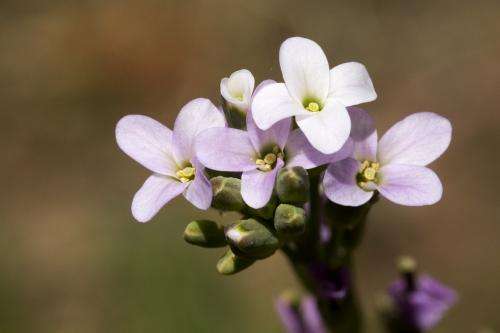Soil microbiomes can set plant flowering time

Scientists grew Boechera stricta plants in soil inoculated with microbes from natural B. stricta habitats to study the flowering time phenotype.
The technique researchers employed to isolate soil microbes to study their effect on a single plant phenotype can potentially be applied to other studies involving microbes within a community and their potential effects on organism phenotypes.
Plant growth is determined by factors such as sunlight, water, and nutrient availability. Figuring out the effect of a particular factor, however, isn't always as easy as monitoring the plant's response to being grown in a dark room compared to how it would fare in the presence of light.
In a study published in the June 2014 issue of Ecology Letters, a team led by Thomas Mitchell-Olds of Duke University and including University of North Carolina plant biologist Jeff Dangl wanted to learn more about the impact of soil, and specifically of the microbial communities in soil, on a plant's flowering time. Flowering time has been known to been affected by factors such as temperature, water availability and pathogens, and the team wondered if microbes could also affect this particular trait in a plant's phenotype.
Duke researchers opted to use Boechera stricta, a relative of the model plant Arabidopsis. They collected soil samples from natural and fairly remote B. stricta habitats in central Idaho, and isolated the microbes. The bacteria and archaea were sequenced at the U.S. Department of Energy Joint Genome Institute (DOE JGI) as part of a 2012 Community Science Program project aimed in part at understanding plant-microbe interactions and the microbiome's influence on complex plant phenotypes. The work is also part of a DOE JGI pilot plant microbiome Grand Challenge project (involving longtime collaborators Thomas Mitchell-Olds and Jeff Dangl and the DOE JGI's Metagenome Program head Susannah Tringe, all authors of the current study) to understand both how plants shape the rhizosphere microbiome and how the rhizosphere shapes plant growth and development.
Back at Duke, Boechera seeds were planted in containers of sterile soils as well as in containers of sterile soils which had been inoculated with microbes from the 4 natural habitat sites (the collection locations were abbreviated as "JAM" for Jackass Meadow, "MAH" for Mahogany Valley, "PAR" for Parker Meadow, and "SIL" for Silver Creek). The team found that the microbes did impact flowering time; for example, the microbiome from the MAH sample site delayed flowering time by 2 days. When the microbial populations from this site were compared against those from the other sample sites, the team found that: "the phyla Proteobacteria and Crenarcheota were more abundant, and Acidobacteria were less abundant, in slow-flowering MAH compared to fast-flowering JAM soil communities. Within phyla, several families… differed in relative abundance between MAH and JAM soil communities…. These 'candidate taxa' are promising organisms for further study of microbial influences on flowering time."
More information: Wagner MR et al. "Natural soil microbes alter flowering phenology and the intensity of selection on flowering time in a wild Arabidopsis relative." Ecol Lett. 2014 Jun;17(6):717-26. DOI: 10.1111/ele.12276
Journal information: Ecology Letters
Provided by US Department of Energy


















